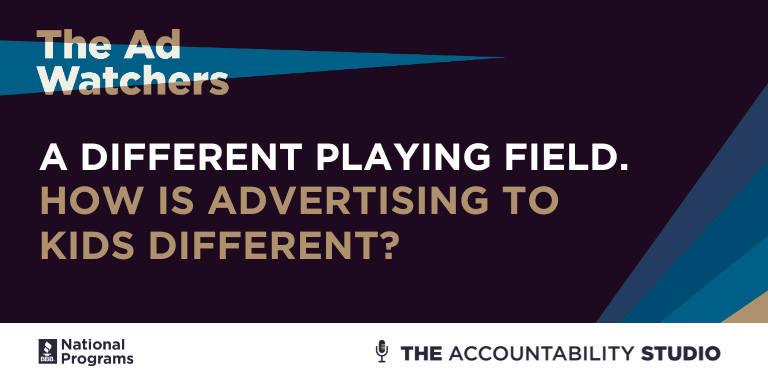
This week on Ad Watchers, hosts Dan Range, an attorney at the National Advertising Division (NAD), and Annie Ugurlayan, NAD’s Assistant Director, are joined by Rukiya Bonner, the director of the Children’s Advertising Review Unit (CARU). This unit is a sister organization to NAD under the BBB National Programs umbrella. It exists to help companies comply with guidelines that protect children from deceptive advertising and ensure that children’s data is collected responsibly. In this episode, the three discuss the extra care required when advertising to children versus adults.
05:07 – Rukiya explains that extra consideration is necessary because young children lack the ability to identify advertising techniques like hyperbole, bandwagon, or puffery. A study from the American Academy of Pediatrics considers children “defenseless against advertising” because kids are more likely to take things literally. They can’t recognize the persuasive nature of advertising and don’t realize that advertisements are trying to convince them to buy something. To young minds, advertisements are simply informative.
When, once upon a time, most advertising was consumed through commercial breaks, promotions were easier to identify. They were interruptive in nature, occurring between programming in a way that screamed, “This is selling something.”
Today, advertising is consumed through web browsers, online videos, and influencer content, and identifying advertising has become more difficult for everyone.
17:30 – Rukiya notes that the lines are blurred further for children consuming content from influencers. Advertisers have long recognized that teenagers respond to advertising that appeals to social status. They use sponsorships with young celebrities and popular influencers to promote products to appeal to that social drive. As the number of young children using YouTube and social media has increased, advertisers have turned to using those same tactics for even more youthful viewers, paying young children to promote toys and games using their online platforms as “kidfluencers.”
These child influencers—as young as one and two years old—are stars of unboxing videos, TikTok dances, and Instagram reels. Though the content is packaged as entertainment, these children are often paid to promote whatever toy, snack, or digital space they’re showing off in the video.
These contemporary forms of sponsorship can blur the lines between advertising and non-advertising. Because of children’s particular difficulty telling the difference, CARU champions clear notifications such as hashtags like “#Sponsored” or “#Ad” and colored borders or other imagery to delineate between paid content and entertainment. The advertiser is responsible for clearly disclosing paid partnerships and endorsements.
24:52 – Annie then introduced listeners to another sister organization supporting CARU in the fight to protect children from harmful advertising. The Children’s Food and Beverage Advertising Initiative (CFBAI) focuses specifically on the self-regulation of food and beverage promotions targeted toward children.
She explains that participants in this initiative commit to only advertising food or beverage products that meet CFBAI’s strict Uniform Nutrition Criteria or not advertising to the demographic at all. The Nutrition Criteria set limits on calories, saturated fat, sodium, and added sugars, as well as minimum contribution levels for essential food groups—fruits, vegetables, and whole grains.
Together, these two initiatives under the BBB National Programs umbrella are working to make the world of advertising a safer space for young minds and bodies. A parent himself, Dan expresses his gratitude for the work these organizations are doing to shield children like his own.
At the end of the episode, he directs listeners to the CARU site, encouraging anyone involved in kid-directed advertising to visit it frequently to stay up to date on the organization’s work and developments in the advertising space.
Visit to Learn More: NAD FAQs
Contact Information: programs@bbbnp.org
Listen to the full episode here.

